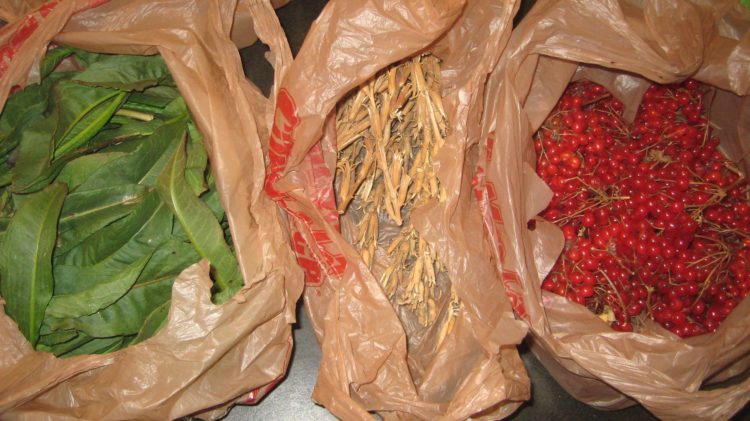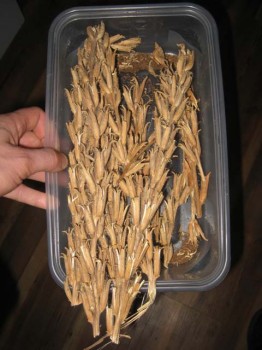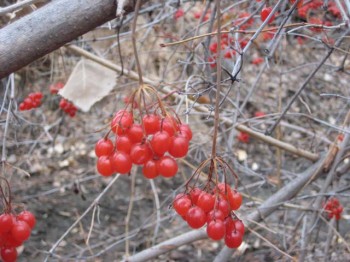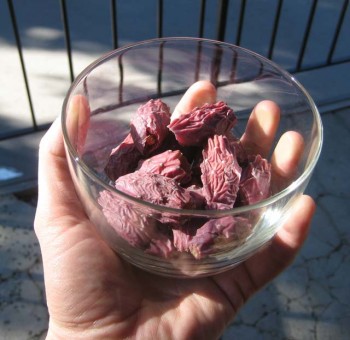
November is not ideal for wild food foraging where I live in Colorado’s high country, aside from pine needles for tea and flavoring or willow bark to sooth the ever-present, new-job-related headache from which I suffer.
You’ll understand why I’m so excited, then, that—after hightailing it from work to Denver for Thanksgiving and driving home to Summit County the next day only to discover I left my computer behind and had to go back to the fiancé’s parents’ house for it—I had opportunity to visit and forage food with my dear friend Butter, and wound up going home with sacks of wild stuff to eat.
These are plants you might be able to spot, right now—and, upon absolute positive identification (of course), get busy with in the kitchen yourself:

Evening primrose seeds
Evening primrose seeds are a good choice if you are interested in collecting and using wild seeds, as are amaranth (Amaranthus spp.), goosefoot (Chenopodium spp.), and dock seeds (Rumex spp.) at this time of year. For culinary ideas, check out B’s wild seed recipe share.
Evening primrose seeds (Oenothera sp.) are apparently quite nutritious. I’ve eaten the roots of spring plants (and by the way, fall is root season too) chopped fine and prepared like horseradish, but I don’t have much experience with the seeds, so this should be fun.
Fresh Dock Leaves
Yes, dock. My love of loves. Most of what you see right now are dry, seed-bearing, rust-colored stalks, some barren of leaves. But in sheltered locales, at least around 5,000 and 6,000 feet, follow the rusty stalk to its base and you might just discover some young, green leaves in the midst of their slimy unfurling.

I’m already halfway through the batch we foraged. I cut the young leaves into thin strips and threw them into my turkey soup—made from a repurposed carcass rescued from the holiday gathering. Free, delicious, nutritious food—there’s nothing better.
Rosehips
The rosehips (Rosa spp.) are shriveling on their stalks already, which means they are at their best, good whole for tea or cooking down (and straining out the seeds) to use as a sauce base or jam. At this stage, their pulpy coats are orange-ish paste. I found some on my nose upon return to the house. I also found dock seeds in my underpants. To quote a reality TV show participant of my acquaintance: “Foraging is an extreme sport.”

Highbush cranberries
Also uncommonly referred to as “stinky sock berries,” the highbush cranberries (Viburnum opulus) we gathered are the plump, red, shiny, abundant-fruiting, and consummately icky berries that Butter says smell like stinky socks and should be cooked outside for that reason. If your mouth is now watering, she has some information and cooking ideas here.
I gathered a few cups in a matter of minutes, and later choked a few down on my drive home. I look forward to making various versions of highly-sugared, cranberry-like sauce experiments with them, as these are another first for me. The berries have a characteristic flat seed inside, but identification by the leaf shape is also important. Fortunately for me, these trees came pre-scouted and I had but to second the ID.
On eating a berry, Gregg surprised me with a positive review and this comment: “It has the taste of fall, similar to that smell of rotting foliage that I love.” This morning, however, he said my stinky berries were leaking and fouling up the refrigerator. Oops.

Prickly pear fruit
I need a wild edible assistant to remove some glochids for me and after that I’ll be golden, I mean purple, with the fruit of wild tunas upon my fingertips and in my mouth. The prickly pears—aka tunas (Opuntia sp.)—we found yesterday, perched at the ends of wilted prickly pear pads lying horizontal in the dry earth, have nothing on the prickly pears of California, but I am tickled to the point of prancing on having taken a small bag of them home from the Front Range.
Stand by for the exciting experiments; or, if you’re too eager to wait, check out B’s prickly pear recipe compilation from the month of September.
Okay so that about does it; I have some wild food eating and preparation to do. If you get inspired to do something with any of these ingredients, drop a line and we can be wild food nerds together.
Updated 3.2.21

I love that you do such a good job of documenting our foraging trips together. They are always some of my favorite memories of the year. But instead of writing about our adventures, as I really ought to, I tend to recline back in my chair, sigh happy sighs, and let little happyface bubbles float off of my brow.
I’m not sure if this is one of those, “you had to be there” occasions, but your writing had me laughing quite hard at several points.
By the way, the theme up my upcoming birthday party is going to be “shriveling but still soft.”